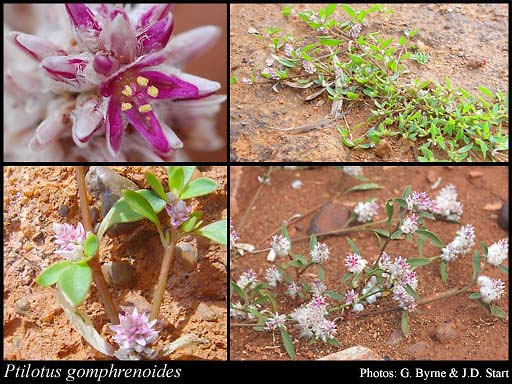- Reference
- Fl.Austral. 5:244 (1870)
- Conservation Code
- Not threatened
- Naturalised Status
- Native to Western Australia
- Name Status
- Current
Erect, decumbent or prostrate annual, herb, (0.01-)0.1-0.4 m high. Fl. pink-purple-white, Mar or May or Jul to Sep. Sand, loam, clay, laterite.







Scientific Description
Annuals, stems several, more or less prostrate, glabrescent or glabrous, with nodose hairs. Leaves present, (4-)8-40 mm long, 1-5 mm wide, glabrous; basal rosette present; cauline leaves opposite or alternate. Spikes pink or magenta, ovoid or cylindrical, solitary or clustered, with densely arranged flowers. Bracts (1.4-)1.5-1.8 mm long, colourless, glabrous, not awned or mucronate, with an obscure midrib. Bracteoles (1.6-)1.8-2.4 mm long, colourless, glabrous, not awned or mucronate, with a prominent midrib. Outer tepals (2.5-)3.3-4.4 mm long, entire. Inner tepals (2.3-)2.8-4 mm long, glabrous within. Style 0.3-0.4(-0.5) mm long, straight, centrally fixed to ovary. Seeds (0.9-)1.1-1.2 mm long, glossy, black. Distribution: Eremaean Botanical Region; IBRA regions: Carnarvon, Gascoyne, Little Sandy Desert, Murchison, Pilbara.
Distribution
- IBRA Regions
- Carnarvon, Gascoyne, Gibson Desert, Murchison, Pilbara, Tanami.
- IBRA Subregions
- Ashburton, Augustus, Cape Range, Carnegie, Chichester, Eastern Murchison, Fortescue, Hamersley, Lateritic Plain, Roebourne, Tanami Desert, Western Murchison, Wooramel.
- IMCRA Regions
- Pilbara (nearshore).
- Local Government Areas (LGAs)
- Ashburton, Carnarvon, Cue, East Pilbara, Exmouth, Halls Creek, Karratha, Meekatharra, Port Hedland, Upper Gascoyne, Wiluna.